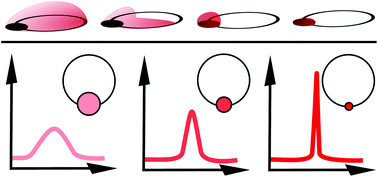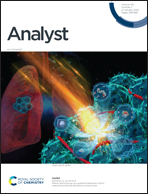Hydrophobic/hydrophilic patterned surfaces for directed evaporative preconcentration†
Abstract
The deposition of micro- and nanolitre volumes is crucial in sessile droplet microfluidic systems. Several techniques exist for the fabrication of surfaces with patterned wettabilities; however, many of these fabrication techniques are time-consuming and complex. Here, we present a device that allows for deposition of multiple droplets within seconds followed by directed evaporative preconcentration. Hydrophobic-coated glass substrates are fashioned with hydrophilic surface energy traps (SETs) using picosecond laser micromachining. SETs can capture nanolitre volumed droplets of both aqueous and organic liquids through discontinuous dewetting. Modification of the machined hydrophilic shape yields a passive mechanism that preconcentrates analyte through evaporation. Studies and optimizations of SET parameters/dimensions (laser power, laser passes, ring/patch diameter) and their effect on patch wettability and degree of preconcentration are presented. As a demonstration, the optimized platform was used to improve the colourimetric detection of cadmium-containing aqueous samples. The optimized SET design demonstrated an 18-fold increase in colourimetric sensitivity compared to conventional milled SETs, suggesting the design would be well-suited for trace analysis. The evaporative preconcentration was also applied to MALDI-IMS analysis of peptides where it resulted in improved uniformity of deposited analyte and decreased analysis times. The rapid droplet deposition and directed evaporative approach can be tailored to provide different concentration factors and is compatible with a wide variety of detection schemes.



 Please wait while we load your content...
Please wait while we load your content...